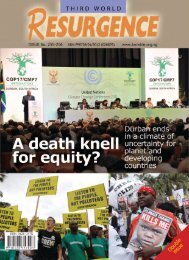Plantations, poverty and power - Critical Information Collective
Plantations, poverty and power - Critical Information Collective
Plantations, poverty and power - Critical Information Collective
You also want an ePaper? Increase the reach of your titles
YUMPU automatically turns print PDFs into web optimized ePapers that Google loves.
39<br />
after an assessment by the Soil Association’s Woodmark. In the UK, the Soil Association is well known<br />
as a promoter of organic agriculture. It is difficult to imagine a form of l<strong>and</strong> management which is further<br />
removed from the Soil Association’s aim of promoting organic agriculture than Sappi’s industrial tree<br />
plantations.<br />
More greenwashing of Sappi’s plantations comes from Professor Julian Evans, a British forester, often<br />
considered to be one of the world’s leading plantation experts. Evans has made his career based in part on<br />
his studies of the pine plantations established to feed the Usutu pulp mill. Professor Evans is apparently<br />
oblivious to the social <strong>and</strong> environmental impacts of industrial tree plantations. For example, at the 2004<br />
meeting of the International Union of Forest Research Organizations, Evans said that<br />
“Productive plantations, whether for industry or energy, need not be ecological deserts devoid of wildlife<br />
or an unwanted l<strong>and</strong>scape, but efficient wood-growing crops managed so as to enrich diversity,<br />
development <strong>and</strong> their desirability as a l<strong>and</strong> use. With plantation forests [sic] ‘you can have your cake <strong>and</strong><br />
eat it’, generating win-win situations. This, I believe, is the future direction for the great bulk of planted<br />
forest [sic].” 167<br />
Evans started monitoring the long-term productivity of the Usutu plantations in 1968. In a 1988 article in<br />
FAO’s Unasylva magazine, he reported on the results of twenty years of studies, <strong>and</strong> assessed “the<br />
various environmental consequences of converting some 52000 ha of high veld grassl<strong>and</strong>s into what is<br />
essentially a pine monoculture.” 168 His description of the plantations as monocultures is accurate.<br />
Unfortunately, little else that Evans has written about Swazil<strong>and</strong> shows similar insightfulness. 169<br />
“Virtually no Swazi villagers were displaced,” according to Evans. Yet, according to Woodmark’s public<br />
summary of their assessment for FSC,<br />
“The majority of Usutu’s l<strong>and</strong>-holdings were previously private title deed portions, belonging to sheep<br />
<strong>and</strong> cattle farmers requiring grazing for only part of the year, or non-resident l<strong>and</strong>-owners who rarely<br />
visited the l<strong>and</strong>. The afforestation drive of the 1950s was preceded by negotiations with local chiefs, after<br />
which assistance was given with relocation to beyond the Company’s property.” 170<br />
A total of 48,000 hectares was bought of which 42,000 hectares was planted, “the remainder being<br />
unplantable ground, fire-breaks, roads <strong>and</strong> l<strong>and</strong> for villages”, notes Evans. By 1988, the company held<br />
67,000 hectares of which 55,000 hectares were planted with pine monocultures.<br />
167 “Economics <strong>and</strong> Management of High Productivity <strong>Plantations</strong>”, International Union of Forest Research<br />
Organizations meeting Lugo, Spain, 27-30 September 2004. http://www.iufro.org/download/file/1357/3661/40402-archivepastevents.doc<br />
168 Julian Evans (1988) “The Usutu forest: Twenty years later”, Unasylva, Vol. 40, No. 159, Food <strong>and</strong> Agriculture<br />
Organization of the United Nations.<br />
http://www.fao.org/docrep/s5780e/s5780e04.htm#the%20usutu%20forest:%20twenty%20years%20later<br />
169 For a more detailed critique of Julian Evans’ work on plantations in Swazil<strong>and</strong>, see Wally Menne <strong>and</strong> Ricardo<br />
Carrere (2007) “Swazil<strong>and</strong>: The myth of sustainable timber plantations”, World Rainforest Movement, March 2007.<br />
http://www.wrm.org.uy/countries/Swazil<strong>and</strong>/book.html<br />
170 “Woodmark Forest Certification Public Report, Sappi Usutu”, Woodmark, Soil Association, July 2006.<br />
http://www.organicweek.org/web/sa/saweb.nsf/librarytitles/22D0E.HTMl/$file/Usutu%20FM%20S1%20report%20FINAL<br />
.xls















